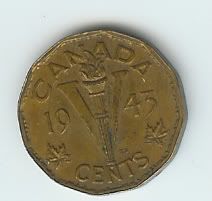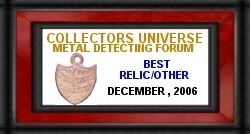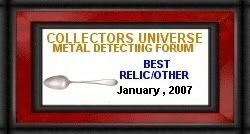WINNER!!: Best "Wildcard" Find December, 2005(finds made without a detector)
Congrats HKnJ!!
Total Votes: 46
#1. HKnJ's 1941 Mecury dime received in change at the Midway Foods mart in Madison, WI.
24 (votes) 52.17 (%)
#2. Dockwalliper's 1943 Canadian Tombac found in the coin return of a Coinstar machine.
10 (votes) 21.74 (%)
#3. SilverDreams' old marble found on the surface while detecting a home site dating to the 1860's.
12 (votes) 26.09 (%)
Please vote for best "Wildcard" find.
#1. HKnJ's 1941 Mecury dime received in change at the Midway Foods mart in Madison, WI.

#2. Dockwalliper's 1943 Canadian Tombac found in the coin return of a Coinstar machine.

#3. SilverDreams' old marble found on the surface while detecting a home site dating to the 1860's.


Total Votes: 46
#1. HKnJ's 1941 Mecury dime received in change at the Midway Foods mart in Madison, WI.
24 (votes) 52.17 (%)
#2. Dockwalliper's 1943 Canadian Tombac found in the coin return of a Coinstar machine.
10 (votes) 21.74 (%)
#3. SilverDreams' old marble found on the surface while detecting a home site dating to the 1860's.
12 (votes) 26.09 (%)
Please vote for best "Wildcard" find.
#1. HKnJ's 1941 Mecury dime received in change at the Midway Foods mart in Madison, WI.

#2. Dockwalliper's 1943 Canadian Tombac found in the coin return of a Coinstar machine.

#3. SilverDreams' old marble found on the surface while detecting a home site dating to the 1860's.


Analog Rules! Knobs and Switches are cool!




0
Comments
<< <i>I'm tied with a marble.
No.... The marble pulled ahead. LOL
Jerry
<< <i>
<< <i>I'm tied with a marble.
No.... The marble pulled ahead. LOL
Jerry >>
My Tombac needs some PR.
During the war, just like in the U.S.,nickel was needed to manufacture goods made of stainless steel and other alloys for the war effort. So in 1942, according to The Charlton Standard Catalogue of Canadian Coins, a decision was made "that nickel would have to be suspended as a coinage material for the duration of the war and experiments were initiated to find a substitute metal for the 5-cent piece."
And the metal alloy they decided to use became known as tombac, from the word tombago, a metal used to make cheap jewelry. The new 1942 12-sided Canadian tombac five-cent coin with the beaver on the reverse was comprised of 88 percent copper and 12 percent zinc. The idea, according to Charlton, was first tried in Britain in 1937 when the Royal Mint produced a 12-sided three pence coin made of nickel and brass.
But the Canadian design on the reverse changed dramatically in 1943. Although the tombac composition of the coin remained the same, Canadian officials decided that a more patriotic symbol supporting the war effort would replace the Canadian beaver on the reverse.
So Thomas Shingles, the Royal Canadian Mint Chief Engraver, designed and engraved a new reverse, this one with a large torch superimposed on a large V. Shingles' initials are clearly visible near the bottom and to the right of the V.
The V represented not only the number five in Roman numerals, but it also represented the V for Victory sign which had become synonymous with Allied hopes of victory over the Axis countries. According to Ralph Yate's article in the November 1965 issue of Coins, this made the Canadian V for Victory coin "the only coin in the British commonwealth, and one of the few in the world, whose design directly reflected the war then raging."
Probably the most interesting part of the design on the 1943 tombac is the Morse code on the reverse. The dots and dashes, which replaced the denticles on the reverse, spell "WE WIN WHEN WE WORK WILLINGLY."
Part of an article by George Manz
<< <i>Well neither of us are catching the Merc.. >>
True....Its gonna be a long cold winter.
They call me "Pack the Ripper"
<< <i>The Tombac is one awesome find. Its a pretty rare coin. I'm going with that. >>
Thank You
Congrats HKnJ